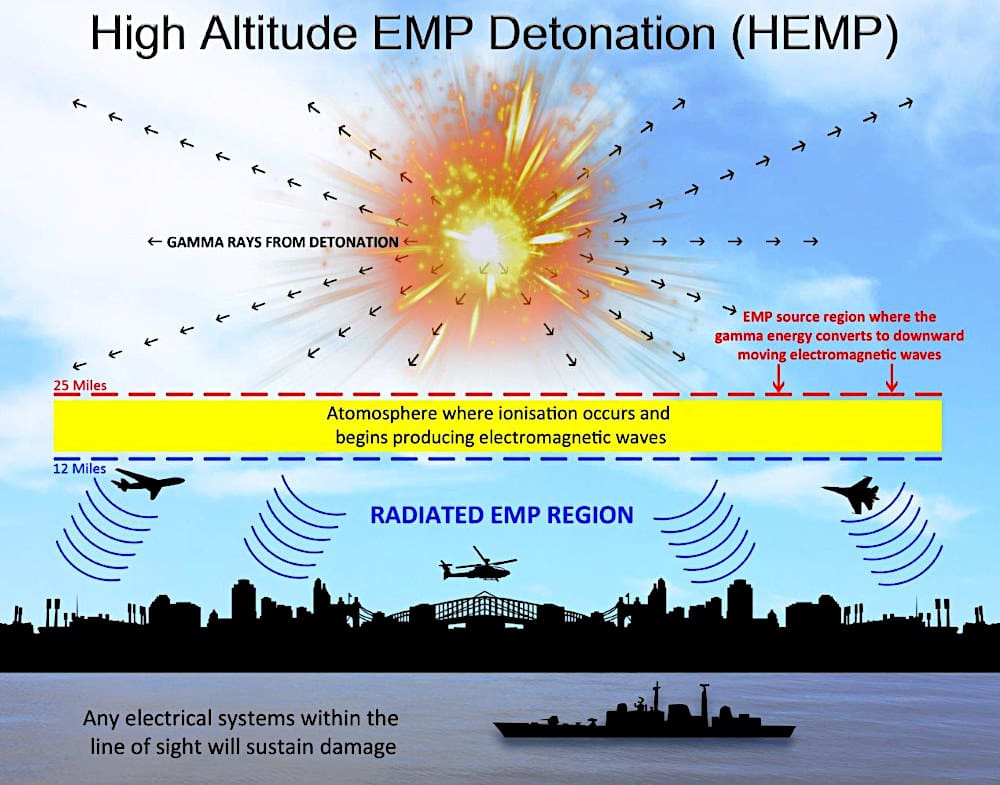Crippling an Electrical Power System
Times have changed. If we are to tell the truth, the world war is already well underway. This article will explain what the consequences of the intentional use of destructive electromagnetic attacks on the power system actually are. There are dozens of evidences of the existence of EMP weapons in many parts of the world.

The deployment of a specialized weapon, capable of crippling an electrical power system and other vital components of national infrastructure without directly impacting human life, is very intriguing due to its potential to precipitate the downfall of an entire nation.
Furthermore, those who are accountable for deciding to deploy such a weapon are not in a position to denounce anyone for the mass slaughter of the civilian populace, as it does not adversely affect humans.
This weapon includes systems that produce highly powerful electromagnetic fields capable of destroying electrical devices and electronic equipment.
- Intentional Destructive Electromagnetic Threats
- How to protect from EMP?
- EMP Damage Circuit Principle
- The Effect of HPEM on Modern Relay Protection Systems
- Attachment (PDF) 🔗 Download ‘Digital Relay Protection For Graduate Students in Electric Power Engineering’
1. Intentional Destructive Electromagnetic Threats
The issue of deliberate destructive electromagnetic threats has increasingly gained relevance in recent years due to two prevailing trends: the growing implementation of microelectronic and microprocessor technology in electrical power engineering, and the rapid advancement of remote weaponry capable of targeting electronic devices.
This issue extends beyond the civilian domain of electrical power engineering to the military, as military bases and training ranges rely on civilian systems for electrical power and water.
Any significant failures in these systems adversely affect the military, despite the protection of their weapon systems against deliberate electromagnetic threats.
Watch Video – High-Altitude Electromagnetic Pulse (HEMP): Potential Impacts
2. How to protect from EMP?
The technology for powerful electromagnetic pulse (EMP) protection is garnering heightened interest, especially for the protection of electronic devices, infrastructure, and communication networks. Electromagnetic pulse (EMP) is potentially harmful and may constitute a significant hazard to essential systems in modern day life.
Researchers and engineers are actively developing several effective protective devices to mitigate the potential impacts of intense electromagnetic pulses (EMPs).
Robust EMPs are evidently more menacing and more challenging to mitigate than EMPs that disrupt one another.
Since the beginning of the 21st century, many forms of potent EMP bombs have emerged globally, prompting nations to increasingly focus on robust EMP protection measures to mitigate the potential effects of significant EMP incidents on essential electronic systems.
A potential EMP can disrupt, damage, or entirely incapacitate circuits, contingent upon the intensity of the electromagnetic wave energy.
Interesting Reading – Automated, but hackable. Is power grid in your country safe from cyberattacks?
Automated, but hackable. Is power grid in your country safe from cyberattacks?
3. EMP Damage Circuit Principle
An EMP attack is an assault that disrupts or damages electronic devices through a powerful electromagnetic pulse produced by its circuitry. EMP attacks primarily encompass two categories: High-altitude Electromagnetic Pulse (HEMP) resulting from nuclear detonations at elevated altitudes and electromagnetic pulses from Non-nuclear Sources (NNEMP). HEMP is induced by electromagnetic radiation emitted from nuclear detonations.
As illustrated in Figure 1, the detonation of nuclear bombs in the atmosphere generates high-energy electrons that, influenced by the Earth’s magnetic field, create a current loop, leading to the phenomena known as EMP.
This EMP propagates rapidly and, due to the reflection and scattering effects of the atmospheric ionosphere, it encompasses a vast area, resulting in damage to numerous electronic items.
Figure 1 – EMP attack schematic


NNEMP, conversely, refers to an electromagnetic pulse produced by a non-nuclear source, typically via an EMP generator or pulsed electromagnetic emitting apparatus.
NNEMP may transmit via wires, antennas, or other electrically conductive materials, and is delivered directly to the target device at short distances.
4. The Effect of HPEM on Modern Relay Protection Systems
Electromagnetic radiation can penetrate electronic equipment primarily through various types of antennas and cable entry points, electrical power supply systems, induced currents within casings and wiring, and radiation passing through non-conductive windows, doors, and ventilation channels.
Currents caused by an EMP within surface and underground power supply cables spanning hundreds to thousands of kilometers can attain thousands of amps, while voltages in the open circuits of these cables may reach millions of volts.
In antenna lead-ins, lengths not exceeding several dozen meters can experience induced currents from an EMP reaching several hundred amps. An EMP that penetrates structural components composed of dielectric materials (such as unshielded walls, windows, and doors) can generate currents of dozens of amps within interior wiring.
Nevertheless, as low voltage circuits and radio-electronic devices typically function at voltages of merely a few volts and currents that may reach several dozen milliamps, it is essential to significantly diminish the currents and voltages at their input terminals to ensure reliable protection from EMP.
Figure 2 – Fiber-optic communication line


In addition to microprocessor-based relay protection systems, optical data transfer devices, commonly utilized in relay protection, exhibit increased susceptibility to electromagnetic pulses (EMP). The controllers that convert electrical impulses into optical signals at one end of the Fibre-Optic Communication Lines (FOCLs) and revert them from optical signals at the opposite end of the FOCL.
Testing with FOCUS-type multiplex equipment compliant with IEC requirements for electromagnetic compatibility revealed that they do not consistently withstand even standard effects without experiencing flashovers or damage.
The SCADA (Supervisory Control and Data Acquisition) system, comprising numerous intelligent sensors and transducers integrated into a computer network, is also susceptible to the impacts of even weakened electromagnetic pulses (EMP).
Communication systems utilizing broadband protocols are the most susceptible to intentional electromagnetic attacks. This pertains to ATM 155, Fast Ethernet, and Gigabit Ethernet, among others; refer to Figure 3.
Figure 3 – A typical oscillogram showing induced electromagnetic interferences in an Ethernet communications link: (a) without data transfer and (b) with data transfer


This can be attributed to a negligible disparity between the power of the legitimate signal and the interference in the higher frequencies of the spectrum. The transition from coaxial cable to a basic twisted pair cable, intended to save costs, makes the whole system increasingly susceptible to vulnerabilities.
Ethernet that employs a twisted pair cable is now being introduced in relay protection and in accordance with the strategy of Smart Grid the use of this cable in controlling all the elements in electrical power engineering is set to grow.
Discrete electronic components show significantly greater resilience to overvoltages and other adverse effects compared to integrated microcircuits. Data indicates that 75% of all damage to microprocessor systems results from overvoltage impacts.
These overvoltages, with amplitudes from several dozen volts to several kilovolts, come from circuit switching operations or electrostatic discharges, and are detrimental to the internal microelements in microcircuits and processors.
The following levels of degradation in semiconductor devices due to intense electromagnetic pulses have been identified: malfunction, enduring modifications in parameters, and catastrophic irreversible failures. These irreversible defects in semiconductors primarily arise due to overheating or flashover events.
Damage to the microprocessor or memory components resulting from diminished electromagnetic effects may be hidden. This damage is undetectable in any tests and may emerge at the most inconvenient times. In addition, under the influence of an EMP mitigated by preventive measures, sporadic reversible failures may arise due to spontaneous alterations in the memory cell contents.
These are referred to as ‘soft failures’ or ‘soft errors.’ Errors of this nature (namely reversible and regenerative failures) were previously unrecognized in electronic devices utilizing discrete semiconductor components or conventional microcircuits.
Watch Video – Why an EMP Attack is Worse than You Think
Recent advancements in nanotechnology have resulted in a substantial decreasing of semiconductor component sizes (down to individual fractions of a micron), a decrease in the thickness of semiconductor and insulation layers, a reduction in operating voltages, an enhancement in operational speed, a decrease in the electrical capacitance of individual memory cells, and an increase in the density of elementary logic cells within a single device.
The cumulative effect of these factors has resulted in a significant increase in the susceptibility of memory elements to electromagnetic influences. This issue is intensified by the observable trend of modern microprocessor architectures, characterized by an increasing utilization of memory parts.
The protective function of a Faraday cage against electromagnetic phenomena is widely recognized.
Structures built with reinforced concrete are equipped with lightning conductors, protective relays are contained within metal enclosures, and the digital protection relay units themselves possess a metallic casing. It seems to resemble a ‘Faraday Russian doll’ rather than a cage.
However, it is not that straightforward. High-frequency pulses readily penetrate gaps in a Faraday cage, as well as non-metallic fuse links, apertures, building windows, and ventilation systems.
Figure 4 – Relay protection room


The impact of a partially weakened EMP on semiconductor devices has resulted in instances of partial destruction of their p-n junctions, leading to alterations in their characteristics and the emergence of “flash” failures in equipment performance.
A significant quantity of functional resources is interconnected by these breakdowns, which also undermine confidence in the apparatus’s reliability. These ‘flash’ failures are often challenging to identify, necessitating the repeated removal of equipment from service, resulting in considerable operational downtime for damage diagnosis.
This element must be considered when evaluating the level of protection for equipment against electromagnetic attacks, as partial or inadequate protection may result in further complications.
As these fields decay this results in rapid voltage variations, which are distributed as waves along the wires in the electrical supply system over relatively long distances from the location of the original pulse. Thirdly, external cables and wires extending for kilometres out from a protective relay cabinet and from a building all but deaden the weakening effect even of the building and the protective relay cabinets.
Further Study – Influence of imminent future techs in power substations
Influence of imminent future techs in power substations (trends, IoT design, cyber security)
5. Attachment (PDF): Digital Relay Protection For Graduate Students in Electric Power Engineering
Download: Digital Relay Protection For Graduate Students in Electric Power Engineering (for premium members only):
References:
- Protection of Substation Critical Equipment Against Intentional Electromagnetic Threats by Vladimir Gurevich
- Systematic Analysis of the Development of Strong EMP Protection by Yonghao Gao












